
Abbott and Costello Meet Frankenstein is a 1948 American horror comedy film directed by Charles Barton. The film features Count Dracula who has become partners with Dr. Sandra Mornay, as Dracula requires a "simple, pliable" brain to reactivate Frankenstein's monster. Dracula discovers that the "ideal" brain belongs to Wilbur Grey who is wooed by Mornay to the operating table, despite the warnings of Lawrence Talbot.

Peter Wilton Cushing was an English actor. His acting career spanned over six decades and included appearances in more than 100 films, as well as many television, stage, and radio roles. He achieved recognition in his home country for his leading performances in the Hammer Productions horror films from the 1950s to 1970s, while earning international prominence as Grand Moff Tarkin in Star Wars (1977).
Hammer Film Productions Ltd. is a British film production company based in London. Founded in 1934, the company is best known for a series of Gothic horror and fantasy films made from the mid-1950s until the 1970s. Many of these involve classic horror characters such as Baron Victor Frankenstein, Count Dracula, and the Mummy, which Hammer reintroduced to audiences by filming them in vivid colour for the first time. Hammer also produced science fiction, thrillers, film noir and comedies, as well as, in later years, television series.

Young Frankenstein is a 1974 American comedy horror film directed by Mel Brooks. The screenplay was co-written by Brooks and Gene Wilder. Wilder also starred in the lead role as the title character, a descendant of the infamous Dr. Victor Frankenstein. Peter Boyle portrayed the monster. The film co-stars Teri Garr, Cloris Leachman, Marty Feldman, Madeline Kahn, Kenneth Mars, Richard Haydn, and Gene Hackman.
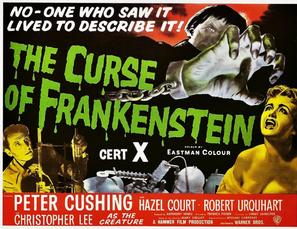
The Curse of Frankenstein is a 1957 British horror film by Hammer Film Productions, loosely based on the 1818 novel Frankenstein; or, The Modern Prometheus by Mary Shelley. It was Hammer's first colour horror film, and the first of their Frankenstein series. Its worldwide success led to several sequels, and it was also followed by new versions of Dracula (1958) and The Mummy (1959), establishing "Hammer Horror" as a distinctive brand of Gothic cinema.

Frankenstein Must Be Destroyed is a 1969 British horror film directed by Terence Fisher for Hammer Films, starring Peter Cushing, Freddie Jones, Veronica Carlson and Simon Ward. The film is the fifth in a series of Hammer films focusing on Baron Frankenstein, who, in this entry, terrorises those around him in a bid to uncover the secrets of a former associate confined to a lunatic asylum.
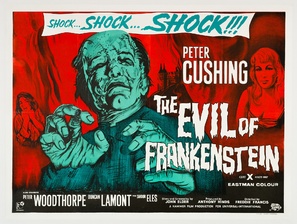
The Evil of Frankenstein is a 1964 film directed by Freddie Francis. The third instalment in Hammer's Frankenstein series, it stars Peter Cushing, Sandor Elès and Kiwi Kingston.
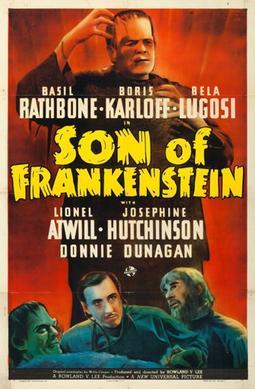
Son of Frankenstein is a 1939 American horror film that was directed by Rowland V. Lee and stars Basil Rathbone, Boris Karloff and Bela Lugosi. The film is the third in Universal Pictures' Frankenstein series and is the follow-up to the 1935 film Bride of Frankenstein. Son of Frankenstein stars Rathbone as Baron Wolf von Frankenstein who, with his wife Elsa and son Peter, return to his late father's estate. Near the castle lives Ygor, a crazed blacksmith whose neck was broken in an unsuccessful hanging attempt. Among the castle's remains, Frankenstein discovers the remains of the monster and decides to try to save his family name by resurrecting the creature to prove his father was correct. He finds, however, the monster only responds to Ygor's commands.

The Invisible Woman is an American science fiction comedy film directed by A. Edward Sutherland. It is the third film in Universal Pictures' The Invisible Man film series, following The Invisible Man and The Invisible Man Returns, which were released earlier in the year. It was more of a screwball comedy than a horror film like the others in the series. Universal released The Invisible Woman on December 27, 1940.
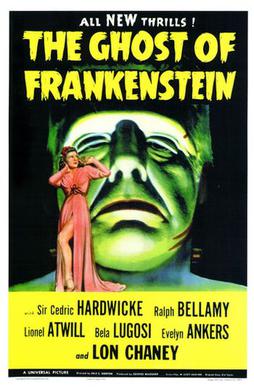
The Ghost of Frankenstein is a 1942 American horror film directed by Erle C. Kenton and starring Cedric Hardwicke, Lon Chaney Jr. and Bela Lugosi. It is the fourth film in the Frankenstein series by Universal Pictures, and the follow-up to Son of Frankenstein (1939). The film's plot follows the previous film's: Frankenstein's Monster and his companion Ygor are chased out of town. They go to another small town to encourage the younger son of Henry Frankenstein to continue his father's experiments, so that Ygor can have revenge against his enemies and his brain transplanted into the Monster's skull.
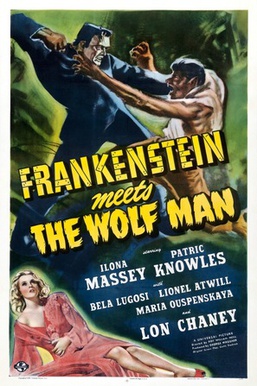
Frankenstein Meets the Wolf Man is a 1943 American horror film directed by Roy William Neill and starring Lon Chaney Jr. as the Wolf Man and Bela Lugosi as Frankenstein's monster. This was the first of a series of later called "monster rallies" combining characters from several film series. This film's script written by Curt Siodmak follows The Ghost of Frankenstein and The Wolf Man. The film involves Larry Talbot who is brought back to life. Seeking a way to return to his death to escape his werewolf curse, he meets with gypsy Maleva who advises him that the only way to stay dead is to confer with Dr. Frankenstein. The doctor is long dead but his equipment is in working condition, leading Talbot to seek the help of scientist Dr. Mannering and Frankenstein descendant Baroness Elsa Frankenstein. Talbot then attempts to have his life sucked from his body and transferred into Frankenstein's monster.
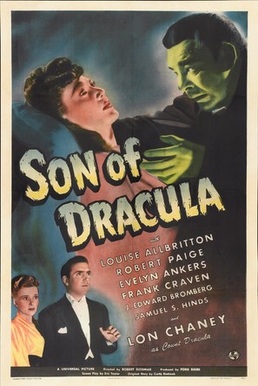
Son of Dracula is a 1943 American horror film directed by Robert Siodmak with a screenplay based on an original story by his brother Curt Siodmak. The film stars Lon Chaney, Jr., Louise Allbritton, Robert Paige, Evelyn Ankers, and Frank Craven. The film is set in the United States, where Count Alucard has just taken up residence. Katherine Caldwell (Allbritton), a student of the occult, becomes fascinated by Alucard and eventually marries him. Katherine begins to look and act strangely, leading her former romantic partner Frank Stanley (Paige) to suspect that something has happened to her. He gets help from Dr. Brewster (Craven) and psychologist Laszlo who come to the conclusion that Alucard is a vampire.

House of Frankenstein is a 1944 American horror film starring Boris Karloff, Lon Chaney Jr. and John Carradine. The film was directed by Erle C. Kenton based on a story by Curt Siodmak, and produced by Universal Pictures. The film is about Dr. Gustav Niemann who escapes from prison and promises to create a new body for his assistant Daniel. The two murder Professor Bruno Lampini and take over his sideshow that involves the corpse of Count Dracula. After disposing of the Count, the two move on to the ruins of Castle Frankenstein where they find the body of Frankenstein's monster and The Wolf Man Larry Talbot preserved in the castle. Niemann thaws them and promises to cure Talbot of his werewolf curse, but secretly plots to revive Frankenstein's monster instead.

House of Dracula is a 1945 American horror film released and distributed by Universal Pictures. Directed by Erle C. Kenton, the film features several Universal Horror properties meeting as they had done in the 1944 film House of Frankenstein. The film is set at the castle home of Dr. Franz Edelmann, who is visited first by Count Dracula and later by Larry Talbot, the Wolf Man, who are trying to cure their vampirism and lycanthropy, respectively. Talbot is eventually cured, which leads him to discover the body of Frankenstein's monster in a cave below the base of the castle. Edelemann takes the monster's body back to his laboratory but finds Count Dracula has awakened and by attacking his assistants, he captures Edelmann and forces a reverse blood transfusion, which gives Edelmann a split personality and makes him a killer.

Lady Frankenstein is a 1971 Italian horror film directed by Mel Welles and written by Edward di Lorenzo. It stars Rosalba Neri, Joseph Cotten, Mickey Hargitay and Paul Müller.
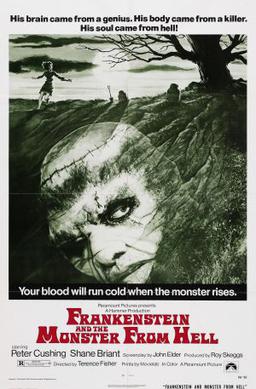
Frankenstein and the Monster From Hell is a 1974 British horror film, directed by Terence Fisher and produced by Hammer Film Productions. It stars Peter Cushing, Shane Briant and David Prowse. Filmed at Elstree Studios in 1972 but not released until 1974, it was the final chapter in the Hammer Frankenstein saga of films as well as director Fisher's last film.

The Revenge of Frankenstein is a 1958 Technicolor British horror film made by Hammer Film Productions. Directed by Terence Fisher, the film stars Peter Cushing, Francis Matthews, Michael Gwynn and Eunice Gayson. In the United States, it was released in June, 1958 with Curse of the Demon on the lower half of the double bill.

Mary Shelley's 1818 novel Frankenstein; or, The Modern Prometheus, and the famous character of Frankenstein's monster, have influenced popular culture for at least a century. The work has inspired numerous films, television programs, video games and derivative works. The character of the Monster remains one of the most recognized icons in horror fiction.

Frankenstein is a film series of horror films from Universal Pictures based on the play version by Peggy Webling and the 1818 novel Frankenstein; or, The Modern Prometheus by Mary Shelley. The series follow the story of a monster created by Henry Frankenstein who is made from body parts of corpses and brought back to life. The rest of the series generally follows the monsters continuously being revived and eventually focuses on a series of cross overs with other Universal horror film characters such as The Wolf Man. The series consists of the following films: Frankenstein (1931), Bride of Frankenstein (1935), Son of Frankenstein (1939), The Ghost of Frankenstein (1942), Frankenstein Meets the Wolf Man (1943), House of Frankenstein (1944), House of Dracula (1945) and Abbott and Costello Meet Frankenstein (1948).
Frankenstein is the title of several horror-adventure films loosely based on the 1818 novel Frankenstein; or, The Modern Prometheus by Mary Shelley, centered on Baron Victor Frankenstein, who experiments in creating a creature beyond human.




















